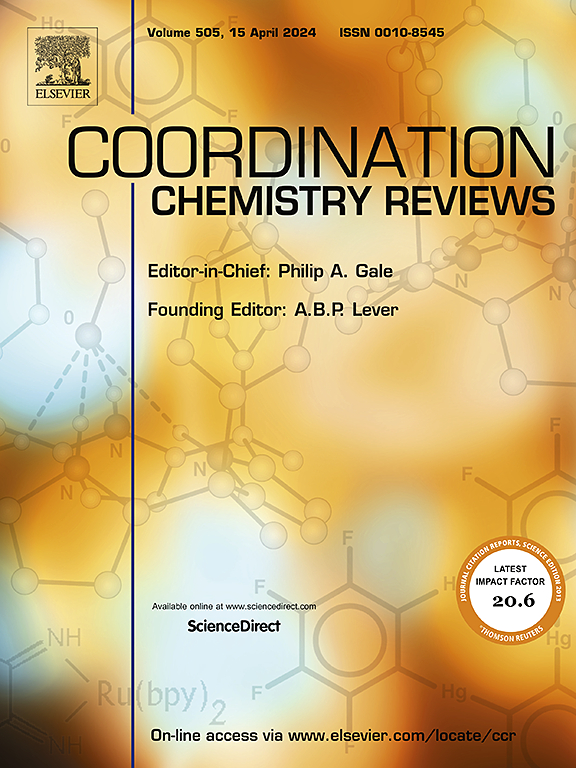Polymer grafting on MXene as a versatile nanoplatform: Synthesis and applications
IF 20.3
1区 化学
Q1 CHEMISTRY, INORGANIC & NUCLEAR
引用次数: 0
Abstract
Polymer grafting on MXene surface and its applications in smart technologies have attracted considerable interest recently. MXenes, a group of two-dimensional (2D) transition metal carbides, nitrides, or carbonitrides, possess remarkable mechanical properties, high surface area, and outstanding electrical conductivity. Covalent polymer grafting on MXene surface through in situ polymerization methods and various coupling reactions forms composite structures with enhanced properties. For example, it can increase the interlayer distance, enhance ion and electron transport, adjust surface hydrophilicity, improve stability in various environments and facilitate the assembly of MXene-polymer structures. These enhanced properties facilitate further development of advanced materials in real-world applications. This review comprehensively examines recent advances in the covalent and non-covalent functionalization of MXenes with polymers, focusing on the underlying coordination chemistry between MXene surface terminations and polymer functional groups. Key advanced polymerization techniques, such as surface-initiated free radical polymerization, controlled radical polymerization, ring-opening polymerization, and Diels-Alder cycloaddition are critically analyzed for their grafting efficiency and control over interfacial architecture. Through case studies across energy devices, sensors, biomedicine, water treatment, and corrosion-resistant coatings, it is highlighted how covalently polymer-grafted MXenes outperform their pristine counterparts. The review concludes by outlining challenges and opportunities for advancing MXene–polymer nanoplatforms through rational design of interfacial chemistry and molecular architecture.


多功能纳米平台MXene的聚合物接枝:合成与应用
MXene表面接枝聚合物及其在智能技术中的应用近年来引起了人们的广泛关注。MXenes是一组二维(2D)过渡金属碳化物、氮化物或碳氮化物,具有卓越的机械性能、高表面积和出色的导电性。通过原位聚合和各种偶联反应在MXene表面接枝共价聚合物形成性能增强的复合结构。例如,它可以增加层间距离,增强离子和电子的传递,调节表面亲水性,提高在各种环境中的稳定性,促进mxene -聚合物结构的组装。这些增强的性能促进了先进材料在实际应用中的进一步发展。本文综述了MXene与聚合物的共价和非共价功能化的最新进展,重点介绍了MXene表面末端与聚合物官能团之间的潜在配位化学。重点分析了表面引发自由基聚合、控制自由基聚合、开环聚合和Diels-Alder环加成等关键的先进聚合技术的接枝效率和对界面结构的控制。通过对能源设备、传感器、生物医药、水处理和耐腐蚀涂层的案例研究,强调了共价聚合物接枝的MXenes如何优于原始的同类产品。总结了通过合理设计界面化学和分子结构来推进mxene -聚合物纳米平台的挑战和机遇。
本文章由计算机程序翻译,如有差异,请以英文原文为准。
求助全文
约1分钟内获得全文
求助全文
来源期刊

Coordination Chemistry Reviews
化学-无机化学与核化学
CiteScore
34.30
自引率
5.30%
发文量
457
审稿时长
54 days
期刊介绍:
Coordination Chemistry Reviews offers rapid publication of review articles on current and significant topics in coordination chemistry, encompassing organometallic, supramolecular, theoretical, and bioinorganic chemistry. It also covers catalysis, materials chemistry, and metal-organic frameworks from a coordination chemistry perspective. Reviews summarize recent developments or discuss specific techniques, welcoming contributions from both established and emerging researchers.
The journal releases special issues on timely subjects, including those featuring contributions from specific regions or conferences. Occasional full-length book articles are also featured. Additionally, special volumes cover annual reviews of main group chemistry, transition metal group chemistry, and organometallic chemistry. These comprehensive reviews are vital resources for those engaged in coordination chemistry, further establishing Coordination Chemistry Reviews as a hub for insightful surveys in inorganic and physical inorganic chemistry.
 求助内容:
求助内容: 应助结果提醒方式:
应助结果提醒方式:


